An Anglicized form of the Sanskrit, avatara, "descent", from the root tr, "pass" (cf. Latin in-trare), and the preposition ava, "down".
The word is used, in a technical sense, in the Hindu re!igion to denote
the descent upon earth of a portion of the essence of a god, which then
assumes some coarser material form, be it animal, monster, or man. Such
descents are ascribed in the mythology of Hinduism to various gods, but
those ascribed to Vishnu are by far the most important. They are
believed to have taken place at different ages of the world, and to have
consisted of different proportions of the essence of the god Vishnu.
Their number is variously stated, ranging from ten to twenty-eight,
finally becoming indefinitely numerous. Any remarkable man is liable to
be regarded as a more or less perfect avatar of Vishnu, and the
consequence one of the worst features of Hinduism - has been the
offering of divine homage to men, especially the founders of religious
sects and their successors.
In Hinduism, an avatar or avatara, is the incarnation (bodily
manifestation) of an Immortal Being, or of the Ultimate Supreme Being.
It derives from the Sanskrit word 'avatara' which means "descent" and
usually implies a deliberate descent into mortal realms for special
purposes. The term is used primarily in Hinduism, for incarnations of
Vishnu the Preserver, whom many Hindus worship as God. The Dasavatara
(see below) are ten particular "great" incarnations of Vishnu.
Unlike Christianity, and Shaivism, Vaishnavism believes that God takes a
special (including human) form whenever there is a decline of
righteousness (dharma) and rise of evil. Lord Krishna, an avatar of
Vishnu, according to Vaishnavism that is espoused by Ramanuja and
Madhva, and God in Gaudiya Vaishnavism, said in the Gita: 'For the
protection of the good, for destruction of evil, and for the
establishment of righteousness, I come into being from age to age.'
(Bhagavad Gita, Chapter 4, verse 8.) In any event, all Hindus believe
that there is no difference between worship of Vishnu and His avatars as
it all leads to Him.The word has also been used by extension by
non-Hindus to refer to the incarnations of God in other religions,
notably Christianity, for example Jesus.
Teachings and Significance
The philosophy reflected in the Hindu epics is the doctrine of the
avatar (incarnation of Vishnu or God as an animal or a human form). The
two main avatars of Vishnu that appear in the epics are Rama, the hero
of the Ramayana, and Krishna, the advisor of the Pandavas in the
Mahabharata. Unlike the superhuman devas (gods) of the Vedic Samhitas
and the abstract Upanishadic concept of the all-pervading Brahman, the
avatars in these epics are intermediaries between the Supreme Being
represented as either Saguna Brahman or Nirguna Brahman and mere
mortals.
This doctrine has had a great impact on Hindu religious life, for to
many it means that God has manifested Himself in a form that could be
appreciated even by the least sophisticated. Rama and Krishna have
remained prominent as beloved and adored manifestations of the Divine
for thousands of years among Hindus. The Upanishadic concept of the
underlying unity of Brahman is revered by many to be the pinnacle of
Hindu thought, and the concept of the avatars has purveyed this concept
to the ordinary Hindu as an expression of the manifestation of the
Hindu's highest single divinity as an aid to humanity in difficult
times. The Hindu cycle of creation and destruction contains the essence
of the idea of "avatars" and indeed relies on a final avatar of Vishnu,
that of Kalki, as the final destructive force at the end of the world.
Aside from Rama and Krishna there are many other human or animal forms
which appeared on earth or elsewhere in the universe. Scriptures do not
describe any appearance as an avatar by Brahma or Shiva (they are
themselves listed as guna avatars) of nirguna Brahman, but emanations of
Vishnu have appeared a number of times. Some Hindus, based on the
Ramayana, aver that Shiva incarnated once as the monkey-god Hanuman.
Hanuman is more well-known as the son of Vayu, the deva of wind or his
emanation. (Hanuman lived in a jungle in Treta Yuga and is called
vanara, which means people having characteristics of monkey, and was one
of the greatest devotees of Vishnu).
Dasavatara
Dashavatara refers to the ten principal avatars. In Vaishnava philosophy, an avatar, most commonly refers to the 'descent' and dais refers to 'ten' in number. The ten most famous incarnations of Vishnu or sometimes Krishna are collectively known as the Dashavatara. This list is included in the Garuda Purana (1.86.10-11) and denotes those avatars most prominent in terms of their influence on human society.
The majority of avatars in this list of ten are categorized as
'lila-avatars'. The first four are said to have appeared in the Satya
Yuga (the first of the four Yugas or ages in the time cycle described
within Hinduism). The next three avatars appeared in the Treta Yuga, the
eighth incarnation in the Dwapara Yuga and the ninth in the Kali Yuga.
The tenth is predicted to appear at the end of the Kali Yuga in some
427,000 years time.
According to the Vishnu Purana and Bhagavata Purana, the Kali-yuga will
end with the apparition of Kalki-avatara, who will defeat the wicked,
liberate the virtuous, and initiate a new Satya Yuga.
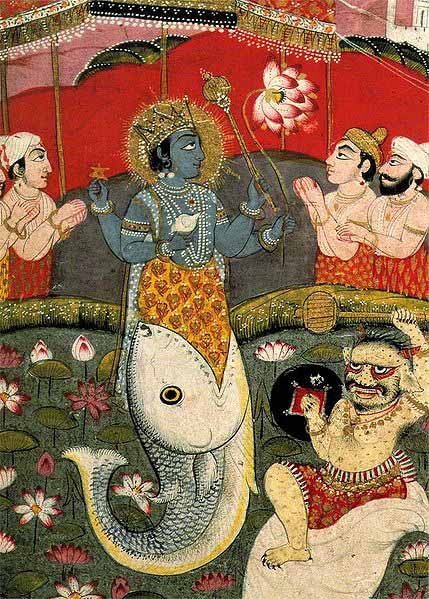
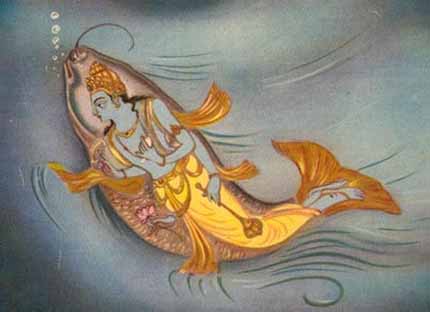
Matsya the Fish appeared in the Satya Yuga and represents beginning of life.
Matsya The Fish
Incarnation is the first incarnation of Vishnu. Lord Vishnu takes the
form of a fish in order to retrieve the Vedas from the demon Hayagriva,
who stole them from Lord Brahma. Without the Vedas, Creation of the
Universe cannot take place. He slayed the demon Hayagriva, recovered the
Vedas, and also saved the pious king Satyavrata from the deluge so that
life and religion can be preserved for the next cycle of Creation.
According to legend, the king Manu was washing his hands in a river
when a little fish swam into his hands and begged him to save it. He put
it in a jar, which it soon outgrew; he successively moved it to a tank,
a river and then the ocean. The fish then warned him that a Great Flood
would occur in a week that would destroy all life. Manu therefore built
a boat which the fish towed to a mountaintop when the flood came, and
thus he survived along with some "seeds of life" to re-establish life on
earth.
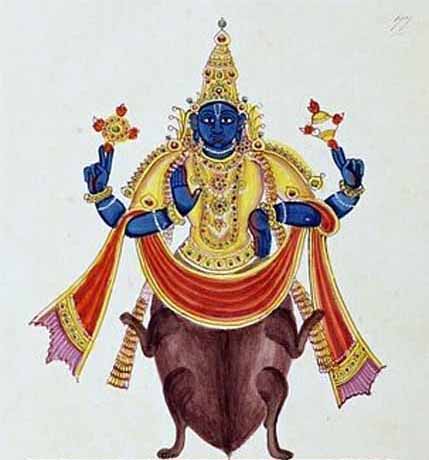
Kurma The Tortoise
Kurma, the tortoise,
appeared in the Satya Yuga. The turtle Incarnation is the second
incarnation of Vishnu. When the devas and asuras were churning the ocean
in order to get the nectar of immortality, the mount Mandara they were
using as the churning staff started to sink and Lord Vishnu took the
form of a turtle to bear the weight of the mountain.
Vishnu in this form offers his back as the pivot on which rests Mt.
Mandara, while the gods and demons churn with it various valuable
objects from the ocean of milk.
In Hinduism, Kurma was the second avatar of Vishnu. He took the form of a
tortoise and sat on the bottom of the ocean after the Great Flood. A
mountain was placed on his back by the other gods so that they could
churn the sea and find the ancient treasures of the Vedic peoples.
The Churning of the Ocean itself forms an interesting legend. In the
ancient times, both the Devas (divinities similar to Greek Gods) were
mortal. Their enemies were the Asuras. One day, the King of the Devas,
Indra was riding his elephant when he came upon a sage. The sage decided
to honor Indra by giving him a scented garland. Indra took the garland,
but placed it on the forehead of his elephant. The elephant was
irritated by the scent and threw the garland off, trampling on it. The
angry sage gave Indra a curse that he and the Devas would begin to lose
all their energy and power.
The Devas feared that the Asuras would take over the whole world.
Therefore, they prayed, and the Hindu Trinity suggested a solution:
churn the Ocean of Milk in order to obtain the Nectar of Immortality.
However, the Devas could not churn the Ocean themselves. They struck a
temporary truce with their enemies so that all could participate in the
churning.
The Ocean was churned by using the mountain Mandara and the snake Vasuki
wrapped around it. Each side would hold an end of the snake and pull on
it alternately, causing the mountain to rotate, which in turn would
cause the Ocean to be churned.
However, once the mountain was put on the Ocean, it began to sink. Then,
Vishnu incarnated in the form of a turtle to support the mountain. As
the ocean was churned, a deadly poison known as Halahalal emerged. This
poison threatened to suffocate all living things. In respons to various
prayers, Shiva drank the poison and held it in his throat. This caused
the throat to turn blue. Then, various people, animals, and treasures
emerged.
These included:
Sura, goddess and creator of wine
Apsaras, various divine nymphs
Kasthuba, the most valuable jewel in the world
Uchhaishravas, the divine horse
Parijata, the wish-granting tree
Kamadhenu, the first cow and mother of all other cows
Lakshmi, the Goddess of Fortune and Wealth
Dhanavantri, the Heavenly Physician, emerged with a pot containing
nectar. As the Asuras rushed to take the nectar, the frightened Devas
appealed to Kurma, who then turned himself into a maiden named Mohini.
The damsel distracted the Asuras, while the Devas secretly drank the
Nectar. One Asura suspected foul play, disguised himself as a Deva, and
drank some Nectar. But before the Nectar could pass his throat, Vishnu
cut off the head. The head, however, remained immortal. It is believed
that this immortal head occasionally swallows the sun or the moon,
causing eclipses. Then, the sun or moon passes through the opening at
the neck, ending the eclipse.
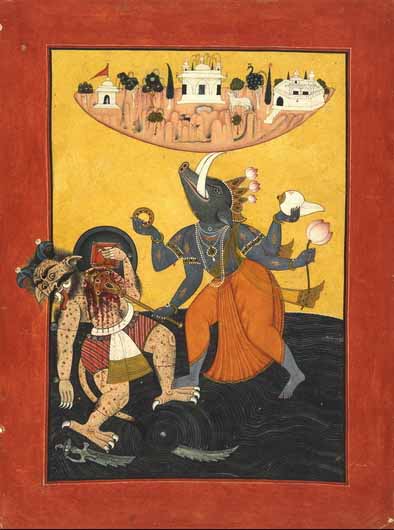
Varaha The Boar
Varaha, the boar,
appeared in the Satya Yuga. The Boar incarnation is the third
incarnation of Vishnu. He appeared in order to defeat Hiranyaksha, a
demon who had taken the Earth (Prithvi) and carried it to the bottom of
what is described as the cosmic ocean in the story. The battle between
Varaha and Hiranyaksha is believed to have lasted for a thousand years,
which the former finally won. Varaha carried the Earth out of the ocean
between his tusks and restored it to its place in the universe.
Varaha is depicted in art as either purely animal or as being
anthropomorphic, having a boar's head on a man's body. In the latter
form it has four arms, two of which hold the wheel and conch-shell and
the other two hold a mace, sword or lotus or form a blessing posture.
The earth is held between the boar's tusks.The avatar symbolizes the
resurrection of the earth from a pralaya (deluge) and the establishment
of a new kalpa (cycle), and can thus be considered to constitute a
creation myth. The Varaha purana is a purana in which the form of
narration is a recitation by Varaha. A very ancient temple lies in Tamil
Nadu goes by the name of Sri Mushnam, and is considered a "svayambhu"
murthi like Tirupati and Badrinath.
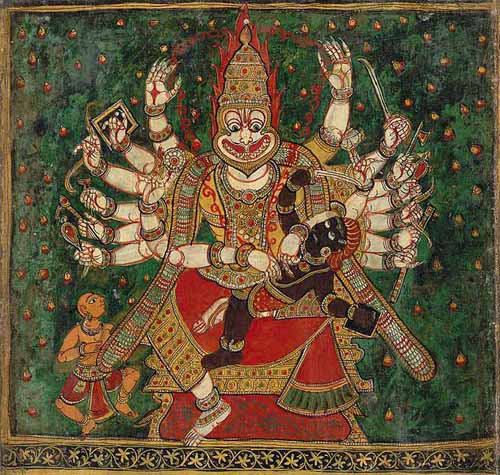
Narasimha The Man-lion
Narasimha The Man-lion
is an avatara of Vishnu described in the Puranas, Upanishads and other
ancient religious texts of Hinduism, and one of Hinduism's most popular
deities, as evidenced in early epics, iconography, and temple and
festival worship for over a millennium.
He is often visualized as half-man/half-lion, having a human-like torso
and lower body, with a lion-like face and claws. This image is widely
worshiped in deity form by a significant number of Vaishnava groups,
particularly in Southern India. He is known primarily as the 'Great
Protector' who specifically defends and protects his devotees in times
of need.
Vishu takes this form to deliver the world from a demon, who had
obtained from Brahma the boon, that he should be slain neither by a god,
a man, nor an animal. In his previous avatar, Vishnu was Varaha and
killed the demon Hiranyaksha, whose brother, Hiranyakashipu, was greatly
angered by this. Hiranyakashipu decided to gain magical powers by
performing a penance for Brahma. Hiranyakashipu asked for a boon from
Brahma that he would not die on Earth or in space, nor in fire or water,
not during the day or night, not inside or outside, and not by the hand
of a human, god, animal or any other animate or inanimate species.
Brahma was pleased with his penance and granted the boon.
Hiranyakashipu, a Daitya, hated the gods and most especially Vishnu, the
followers of whom he began to torture. Hiranyakashipu's son, Prahlada,
was a very devoted follower of Vishnu. Hiranyakashipu failed in
convincing his son to join him against Vishnu, and tried to kill him,
but Prahlada was protected by Vishnu. When asked, Prahlada refused to
acknowledge his father as the supreme lord of the universe (though he
had used his boon to conquer the entire world) and claimed that Vishnu
was omnipresent.
Hiranyakashipu asked if Vishnu was in a particular pillar and Prahlada
answered he was. Hiranyakashipu smashed the pillar, and Narasimha came
from it. Narasimha killed Hiranyakashipu, since he was neither human nor
animal nor god (an avatar is a human, but this avatar was only part
human and part animal) and did so during twilight (neither day nor
night), placing him on Narasimha's thighs (not on earth, nor in space),
on the threshold of the entrance to a courtyard (neither inside nor out)
and using nails (neither animate nor inanimate) as weapons.
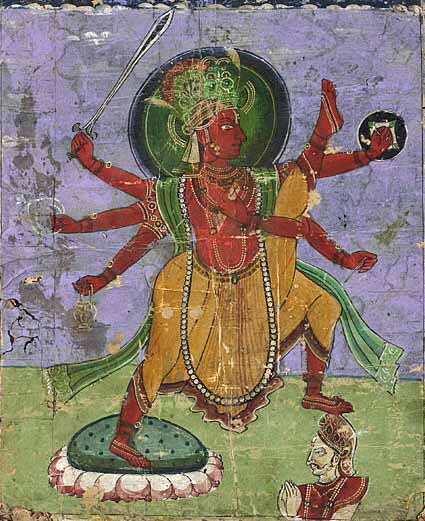
Vamana The Dwarf
Vamana, the dwarf,
appeared in the Treta Yuga. The fourth lineal descendant of
Hiranyakashyap, named Bali, through his devotion and penance defeated
Indra, the god of firmament, humbled other gods and extended his
authority over the three worlds. All the gods appealed to Lord Vishnu
for protection and He became manifest in His Dwarf Avatar of Vaman for
the purpose of restraining Bali.
Once when this king was making a great religious offering, Lord Vishnu
in the form of Vaman appeared before him in the company of other
Brahmins. Bali was extremely pleased to see a holy man with such a
diminutive form and promised to give him whatever he should ask.
Lord Vishnu asked only for as much land as he could measure by three
steps. Bali laughingly agreed to grant the boon of three steps. Lord
Vishnu as dwarf stepped over heaven in first stride and earth in the
second stride. Then he asked Bali where can he put his third step . Bali
realized that Vamana was Vishnu incarnate and his pride was broken. He
offered Vamana to put his third step on his head.
Vamana did so and thus blessed Bali marking him as one of the few
immortals blessed by Vishnu. Then out of respect to Bali's kindness and
his grandfather Prahlad's great virtues, he made him the ruler of
pathala, the subterranean region. Bali is believed to have ruled Kerala
and Tulunadu. He is still revered there as the king of prosperity and
remembered and called on before the harvesting season.
Vamana defeats the Devas' (Gods') enemy Bali Chakravarthi (of the demon
race) into giving up all of the heavens and earth. King Bali, in an
attempt to cement his place as the ruler of all Three Worlds (i.e. the
Universe), performed a series of grand yajnas (prayers/sacrifice). The
Gods feared that this would cause evil to stalk the Universe, so they
prayed to Mahavishnu to assist them. On King Bali's last yajna, Vamana a
small brahmana boy appeared.
The King was delighted to be graced by the presence of such a holy
being, and offered Vamana anything that he wished for. Vamana asked for a
piece of land only three paces wide and Bali laughs at the proposal,
highlighting the great wealth and land that he owns. However he
nonetheless agrees to this wish, against Asuraguru Sukracharya's warning
that Vamana is in fact the avatar of Mahavishnu who has come once again
to defeat the demon race. King Bali agrees, but this invokes the anger
of his spiritual master, Sukracharya, who curses him. King Bali presents
Vamana his gift, whereupon Vamana grows in size and steps across the
earth in one step, the heavens in the second step. Having now conquered
all of Bali's wealth, Vamana asks him where he should place his third
step. King Bali, in trying to fulfill his promise, offered his head as
the third place. Thus Vamana places his third step on King Bali's head,
defeating him completely.
Vamana taught King Bali that arrogance and pride should be abandoned if
any advancement in life is to be made, and that wealth should never be
taken for granted since it can so easily be taken away. Vamana then took
on the form of Mahavishnu. He was pleased by King Bali's determination
and ability to keep his promise in the face of his spiritual master's
curse and the prospect of losing all his wealth. Vishnu named the King
Mahabali since he was a Mahatma (great soul). He allowed Mahabali to
return to the spiritual sky to associate with Prahalada (the demoniac
Hiranyashipu's pious son, also a descendant of the demon race) and other
divine beings. Mahavishnu also declared that Mahabali would be able to
rule the universe in the following yuga (age).
Bali is supposed to return every year to the land of his people, to
ensure that they are prosperous. This is celebrated as the Onam festival
in Kerala, where he is also called Maveli.

Parashurama Rama with the Axe
Parashurama, Rama
with the axe, appeared in the Treta Yuga. Parashurama a Brahmin, the
sixth avatar of Vishnu, belongs to the Treta yuga, and is the son of
Jamadagni and Renuka. Parashu means axe, hence his name literally means
Rama-of-the-axe. He received an axe after undertaking a terrible penance
to please Shiva, from whom he learned the methods of warfare and other
skills.
Parashurama is said to be a "Brahma-Kshatriya" (with the duties between a
Brahmana and a Kshatriya), the first warrior saint. His mother is
descended from the Kshatriya Suryavanshi clan that ruled Ayodhya and
Lord Rama also belonged to. A haihaya King Kartavirya Arjuna
(Sahasrarjuna - purportedly with a thousand arms) and his army visited
Jamadagni, a Brahmin sage, who fed his guest and the whole army with his
divine cow Kamadhenu.
The king demanded the magical cow. Jamadagni refused because he needed
the cow for his religious ceremonies. King Kartavirya Arjuna
(Sahasrarjuna) took the cow forcibly and devastated the ashram. Angered
at this, Parashurama killed the king's entire army and, after cutting
each one of his thousand arms, the king himself with his axe. As a
revenge, the King's sons killed Jamadagni in Parashurama's absence.
Furious at his father's murder, Parashurama killed all sons of
Sahasrajuna and their aides. His thirst for revenge unquenched, he went
on killing every adult Kshatriya on earth, not once but 21 times,
filling five ponds with blood. These are the actions which highlight his
warrior characteristics. Ultimately, his grandfather, Richeek Rishi,
appeared and stopped him.
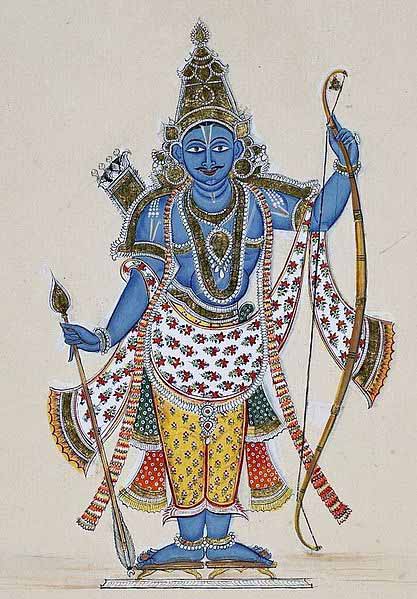
Lord Rama
Rama Ramachandra, the
prince and king of Ayodhya, appeared in the Treta Yuga. Lord Rama is one
of the most commonly adored gods in Hinduism and is known as an ideal
man and hero of the epic Ramayana. Lord Rama defeated and killed the
king of Sri Lanka, Ravana for capturing and imprisoning his wife Sita in
the Ashoka Garden in Sri Lanka.
He is considered to be the seventh avatar of Vishnu in Hinduism, and a
mythological king of Ayodhya in ancient Indian Puranas. He was born in
Suryavansha, later known as Raghuvnsha after king Raghu. Based on
Puranic genealogy, Rama is believed by Hindus to have born 20 Million
years ago..
Rama is one of the many popular figures and deities in Hinduism,
specifically Vaishnavism and Vaishnava religious scriptures in South and
Southeast Asia.
In Ayodhya - the Indian city believed to be the birthplace of Rama, he
is also worshipped as an infant or Rama Lalla. Most of the details of
Rama's life come from the Ramayana, one of the two great epics of India.
Born as the eldest son of Kausalya and Dasharatha, king of Ayodhya,
Rama is referred to within Hinduism as Maryada Purushottama, literally
the Perfect Man or Lord of Self-Control or Lord of Virtue. Rama is the
husband of Sita, whom Hindus consider to be an avatar of Lakshmi and the
embodiment of perfect womanhood.
Rama's life and journey is one of perfect adherence to dharma despite
harsh tests of life and time. He is pictured as the ideal man and the
perfect human. For the sake of his father's honor, Rama abandons his
claim to Kosala's throne to serve an exile of fourteen years in the
forest. His wife Sita and brother Lakshmana, unable to live without
Rama, decide to join him, and all three spend the fourteen years in
exile together. This leads to the kidnapping of Sita by Ravana, the
Rakshasa (Asura) monarch of Lanka.
After a long and arduous search that tests his personal strength and
virtue, Rama fights a colossal war against Ravana's armies. In a war of
powerful and magical beings, greatly destructive weaponry and battles,
Rama slays Ravana in battle and liberates his wife. Having completed his
exile, Rama returns to be crowned king in Ayodhya (the capital of his
kingdom) and eventually becomes emperor, rules with happiness, peace,
prosperity and justice - a period known as Rama Rajya.
Rama's courage in searching for Sita and fighting a terrible war to
rescue his wife and their honour is complemented by Sita's absolute
devotion to her husband's love, and perfect chastity despite being
Ravana's captive. Rama's younger brothers, namely Lakshmana, Shatrughna
and Bharata strongly complement his piety, virtue and strength, and they
are believed by many to belong to the Maryada Purushottama and the
Seventh Avatara, mainly embodied by Rama. Rama's piety and virtue
attract powerful and devoted allies such as Hanuman and the Vanaras of
Kishkindha, with whose help he rescues Sita. The legend of Rama is
deeply influential and popular in the societies of the Indian
subcontinent and across South East Asia. Rama is revered for his
unending compassion, courage and devotion to religious values and duty.
Rama is the great hero of the Hindu Odyssey, the Ramayana, who is made
into an avatar of Vishnu. Rama was a real or mythical king in ancient
India, whose life and heroic deeds are related by the Sanskrit epic
Ramayana.
Astronomical data in the Ramayana has been interpreted to suggest that
his reign was would have been at approximately 2015 BC, however the
Ramayana was written many centuries after this date, probably two
thousand years later. It cannot be taken as an accurate guide to the
life of the historical Rama, except by devout Hindus. In Hinduism, Rama
is regarded as the seventh avatar of the god Vishnu and worshipped
together with his companion Hanuman, the monkey-god who assists him in
the epic narrative of the Ramayana.
He is the Prince of Ayodhya and is banished to a forest by his
stepmother. While in exile, his wife, Sita, is kidnapped by Ravana, King
of the Rakshas on Lanka (cur: Sri Lanka). Rama, along with Hanuman,
rescued her, killed Ravana and becomes King of Ayodhya. Rama also killed
Vali, the monkey-King of Kishkindhya. He is protected during his
adventures by Agastya, and also rescued Ahalya after she was turned to
stone by her husband for having an affair with Indra. In recent years
the cult of Rama has become associated with Hindu Nationalism. Rama is
held up as a model of Hindu devotion to caste and the rules of dharma,
and as a militant opponent of those who would break with it.
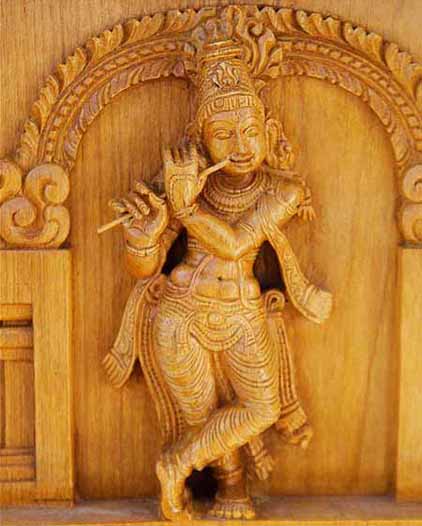
Krishna

Krishna
(meaning 'dark colored' or 'all attractive') appeared in the Dwapara
Yuga along with his brother Balarama. According to the Bhagavata Purana
Balarama is said to have appeared in the Dwapara Yuga (along with
Krishna) as an incarnation of Ananta Shesha. He is also counted as an
avatar of Vishnu by the majority of Vaishnava movements and is included
as the ninth Dasavatara in some versions of the list which contain no
reference to Buddha.
Because of his great Godly power, Lord Krishna is another of the most
commonly worshipped deities in the Hindu faith. He is considered to be
the eighth avatar of Lord Vishnu. He played a huge role in the Battle of
Kurukshetra and helped the Pandavas defeat the Kauravas. He is also a
significant character in the epic of Mahabharata. Shree Krishna
delivered Bhagwad Gita on battlefield of the Battle of Kurukshetra to
Arjun.
He, like Lord Rama, is also known for his bravery in destroying evil
powers throughout his life. The Lord is usually depicted as playing the
flute (murali), indicating spread of the melody of love to people.
As the Indian Hercules as he is styled by Megasthenes, the most popular
hero of India, is the most perfect avatar of Vishnu. Krishna (meaning
black as well as all-attractive one) is a Hindu god, and is popularly
considered one of the avatars of Vishnu. Another perspective presents
Krishna as existing prior to any material manifestation and prior to any
God such as Vishnu, who is assigned the task of maintaining the
material manifestation.
In this view, Krishna is considered the Supreme Lord. Perhaps the best
way to explain the relationship between Krishna and Vishnu is to
consider them to be irrevocably linked and that one is the expansion of
the other. The Bhagavad Gita, a section of the ancient epic Mahabharata,
describes the teachings imparted by Krishna to Arjuna at the beginning
of the great battle at Kurukshetra.
Parthasarathy is a name of Krishna that refers to his being the
charioteer (sarathy) of Arjuna at this time, a name that endears Krishna
to Arjuna, who becomes blissful whenever he contemplates how merciful
it is that Krishna has consented to become his charioteer. Stories of
Krishna's childhood and youth depict him as mischievous and clever,
showing that even God has a sense of humor.
He is found stealing clothes from the Gopis, breaking the butterpot for
ghee, and playing transcendental pranks. This is a counterpoint to
another avatar of Vishnu: Rama, he of the straight and narrow path.
Krishna also is involved in defending honor, and in fighting demonic
personalities. In one such story, Vishnu told Krishna to kill Kamsa, a
tyrant and a son of a demon. Krishna and his brother Balarama were
threatened by Kamsa, who had been told a son of his half-sister Devaki
would kill him. He therefore murdered her first six children. Krishna
and Balarama were moved to Rohini's womb to protect them. Krishna was
then given to Nanda and Yasoda to hide him from Kamsa; as a child, he
was known as Balakrsna, one of hundreds of names for Krishna.
Of all names, Krishna, or all attractive, is considered the topmost.
Krishna is 'Sat Cit Ananda', full of bliss and knowledge. To a Hindu,
all living entities are part and parcel of Krishna, and each living
entity walks within a world made up of the material energy, another one
of Krishna's unlimited energies. The amorous pastimes of Krishna are
popularly misunderstood and should not be attempted until the nature of
Krishna is fully inderstood. For example, to fulfill the desires of his
devotees he expanded to be personally present to His sixteen-thousand
wives. On one hand this seems adulterous, whereas on the other hand, as
expansions of Krishna, all husbands are part and parcel of Krishna and
therefore ultimately Krishna is indirectly married to all wives.
Despite all these transcendental activities, Krishna's favorite is
Radha, daughter of Vrishabhanu. When Krishna advented in Vrindavana,
Radha followed within two years. However, she would not open her eyes
until Krishna was present before Her. At Her first birthday Krishna,
then three, came and pulled down the veil of her crib. She opened her
eyes for the first time then. Until Krishna appeared before her, it was
as if there was nothing on this earth worthwhile for Radha to see. Radha
is the prime object of Krishna's love, and is joined with Him as the
Fountainhead of all Spiritual Energy from which the material universes
emanate.
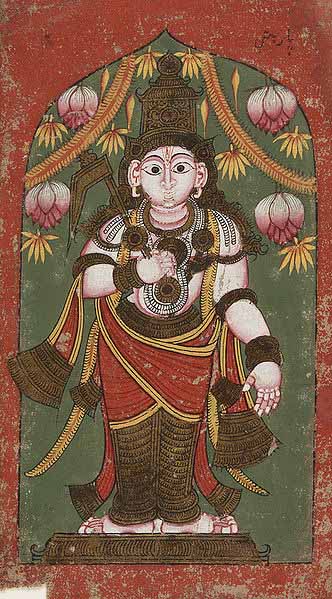
Balarama
Balarama is the
elder brother of the divine being, Krishna in Hinduism. Within
Vaishnavism and a number of South Indian, Hindu traditions Balarama is
worshipped as an avatar of Vishnu, and he is also listed as such in the
Bhagavata Purana. Within both the Vaishnava traditions and Hinduism
generally he is acknowledged as being a manifestation of Shesha, the
serpent on whom Vishnu rests.
The Bhagavata Purana describes Krishna as the original Supreme
Personality of Godhead from whom everything else emanates. As part of
this divine 'emanation', Krishna's very first expansion is Balarama, and
from Balarama all other incarnations of God then appear. Of the three
transcendental elements described in Sanskrit as sat, cit and ananda
(eternity, knowledge and bliss), Balarama is in charge of eternity and
knowledge. Hence he is worshipped as the supreme teacher or Adiguru.
In Hinduism, Balarama (phonetically Balar ma - his other names include
Baladeva, Balabhadra and Halayudha) is the name of the elder brother of
Sri Krishna. Most South Indian Hindu sects and some Vaishnava sects
based in eastern India regard Balarama as being the ninth avatar of
Vishnu. In either tradition, Balarama is acknowledged as being a
manifestation of Shesha, the divine serpent on whom Vishnu rests.
The sacred Hindu scripture Bhagavata Purana explains how Krishna is the
Supreme Personality of Godhead from whom everything emanates. In doing
so, his first expansion is Balarama. From Balarama all other
incarnations of God appear. Of the three transcendental elements (sat,
cit and ananda), Balarama is in charge of sat(Sanskrit: eternity or
truth), cit (Sanskrit: knowledge or consciousness). Hence he worshiped
as the supreme teacher or adiguru. (Note: Ananda (Sanskrit: happiness or
bliss.)
Balarama was conceived as a son of Vasudeva and Devaki. Kamsa, brother
of Devaki and an evil king, was intent upon killing all the progeny of
Devaki, because of a prediction that Kamsa would die at the hands of the
eighth son of Devaki. Kamsa threw his sister Devaki and her husband
Vasudeva into jail, and proceeded to kill each of their children as soon
as they were born.
In due course of time, Devaki bacame pregnant for the seventh time.
However, this child was not destined to meet the fate of the six
previous infants. The unborn child was miraculously transferred from the
womb of Devaki to the womb of Rohini, who had long been craving a child
of her own. Thus Balarama's other name is also Sankarsana which
describes the transfer of the child from the womb. The child was
formally named Rama, but because of his great strength he was called
Balarama (Strong Rama).
Thus, Rohini actually gave birth to Balarama and raised him. Balarama
spent his childhood as a cowherd boy with his brother Krishna and
friends. He later married Revati, the daughter of King Raivata, ruler of
the Anarta province.
Balarama is almost always depicted as being fair skinned, especially in
comparison to his brother, Krishna, who is shown as dark blue or black
in hue. His weapons are the plough and the mace. Traditionally Balarama
wears blue garments and a garland of forest flowers. His hair is tied in
a topknot and He has earrings, bracelets and armlets. Balarama is
described as being very physically strong, in fact 'bala' in Sanskrit
refers to 'strength'. Sri Baladeva is famous as being Krishna's dearest
friend.
In the Bhagavata Purana it is described that after Balarama took part in
the battle that caused the destruction of the rest of the Yadu dynasty,
and after He witnessed the disappearance of Lord Krishna, He then sat
down in a meditative state and departed from this world by producing a
great white snake from His mouth, and thus He was carried by Sesha in
the form of a serpent.
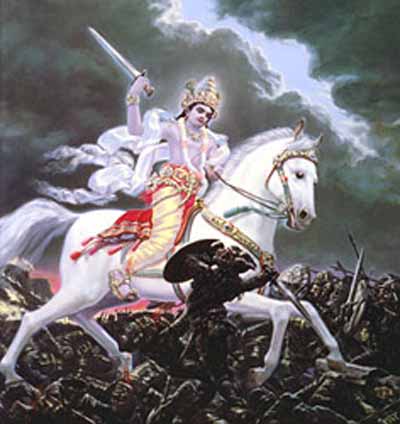
Kalki
Kalki is described as
the last of the Maha Avatars of Lord Vishnu, who will appear to end the
Kali Yuga or the Dark Age. In Hindu traditions, Kalki (also rendered by
some as Kalkin and Kalaki) is the name of the tenth and final Maha
Avatara (Great Avatar) of Vishnu the Preserver, who will come to end the
current Kali Yuga, (The Age of Darkness and Destruction).
The name Kalki is often a metaphor for "Eternity" or "Time". The origins
of the name probably lie in the word Kalka which refers to "dirt",
"filth" or "foulness" and hence denotes the "Destroyer of Foulness",
"Destroyer of Confusion", "Destroyer of Darkness", or "The Annihilator
of Ignorance". In Hindi kal ki avatar means "tomorrow's avatar". Other
similar and divergent interpretations (based on varying etymological
derivations from the ancient Sanskrit language, including one simply
meaning "White Horse") have been made.In the Buddhist Kalachakra
tradition, the Kalki (or Kulika) is the ruler of the legendary Kingdom
of Shambhala, where the whole of society is enlighted and the Kalachakra
tantra is held and widely practiced. In this form Vishnu will descend
when the world is wholly depraved, destroy utterly the wicked, and
restore the happy conditions of the Age of Virtue.
In Hinduism, Kalki (alt. spelling: Kalaki) ('Time") is the tenth and
last avatar of Vishnu. Kalki is expected to appear on Earth at the
conclusion of the current Kali Yuga; He will come from the sky on a
white horse, brandishing a flaming sword with which to destroy the
wicked people of the current world, renew creation and bring
righteousness back to Earth.
According to Hindu scripture, Kali Yuga (the Age of Kali) began
at the end of Krishna's bodily lifespan near the end of the 15th century
BC and will last exactly 432,000 years - placing its conclusion near
the middle of the 431st millennium AD. Kalki, the 10th and final avatar
of Vishnu, is expected to appear at this time, riding a white horse and
wielding a flaming sword with which to strike down the wicked.
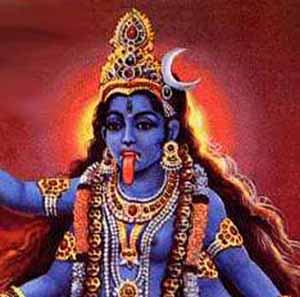
Kali Yuga
Kali Yuga is the
last of 4 Yugas. Upon its conclusion, the world will "reboot" into a new
Satya Yuga (Golden Age.) This involves the end of the world as we know
it and the return of the Earth to a state of paradise. According to most
interpretations of Hindu scriptures, including the Vedas, the Kali Yuga
(Age of Kali, also known as Iron Age) began at the end of Krishna's
bodily lifespan (approximately 5100 years ago, 3102 BCE) and will last
exactly 432,000 years - placing its conclusion in the year 428,899 CE
(it began with a year 0). Kalki, the 10th and final avatar of Vishnu, is
expected to appear at this time, riding a white horse and wielding a
flaming sword with which to strike down the wicked. Kali Yuga began at
midnight (00:00) on February 18, 3102 BCE according to the Surya
Siddhanta, which is an astronomical treatise that forms the basis of all
Hindu and Buddhist calendars.
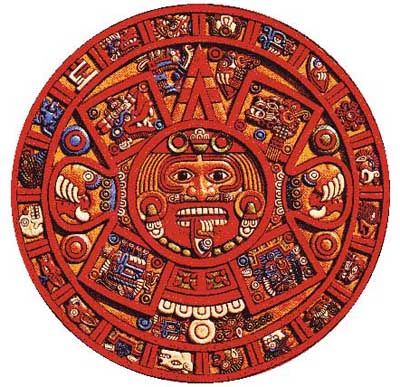
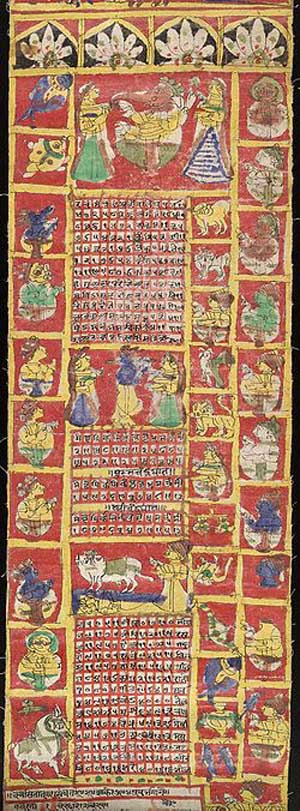
Trimurti
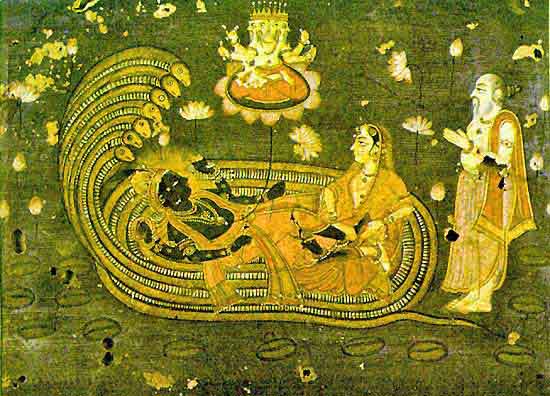
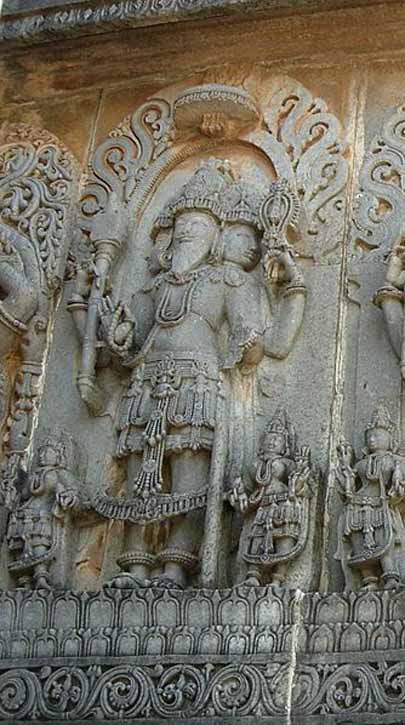
In Hinduism, the Trimurti 'three forms' - is a concept in Hinduism "in which the cosmic functions of creation, maintenance, and destruction are personified by the forms of Brahma the creator, Vishnu the maintainer or preserver, and Shiva (Kali) the destroyer or transformer." These three deities have been called "the Hindu triad" or the "Great Trinity". Of the three members of the Trimurti, the Bhagavata Purana, which espouses the Vaishnavite viewpoint, explains that the greatest benefit can be had from Vishnu.
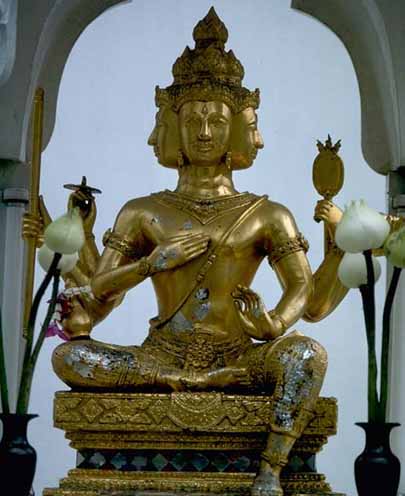
Brahma is the Hindu god (deva) of creation and one of the Trimurti, the others being Vishnu and Shiva. He is not to be confused with the Supreme Cosmic Spirit in Hindu Vedanta philosophy known as Brahman. Also, in Sanskrit Grammer, Brahman is Nominative Singular of generic word Brahman, as Aatma is Nominative Singular for Aatman. Brahaman and Aatman are same in Vedanta Philosphy, the Para-Aatma (Supersoul) and Jeeva Aatma (Individual Soul) are Brahman. His consort is Saraswati, the goddess of learning. Brahma is often identified with Prajapati, a Vedic deity.
According to the Puranas, Brahma is self-born (without mother) in the lotus flower which grew from the navel of Vishnu at the beginning of the universe. This explains his name Nabhija (born from the navel). Another legend says that Brahma was born in water. In this he deposited a seed that later became the golden egg. From this golden egg, Brahma the creator was born, as Hiranyagarbha. The remaining materials of this golden egg expanded into the Brahmanda or Universe. Being born in water, Brahma is also called Kanja (born in water). Brahma is said also to be the son of the Supreme Being, Brahman and the female energy known as Prakrti or Maya.
At the beginning of the process of creation, Brahma created eleven Prajapatis (used in another sense), who are believed to be the fathers of the human race. The Manusmriti enumerates them as Marichi, Atri, Angirasa, Pulastya, Pulaha, Kratu, Vasishtha, Prachetas or Daksha, Bhrigu, and Narada. He is also said to have created the seven great sages or the Saptarishi to help him create the universe. However since all these sons of his were born out of his mind rather than body, they are called Manas Putras or mind-sons.
Within Vedic and Puranic scripture Brahma is described as only occasionally interfering in the affairs of the other devas (gods), and even more rarely in mortal affairs. He did force Soma to give Tara back to her husband, Brihaspati. He is considered the father of Dharma and Atri.
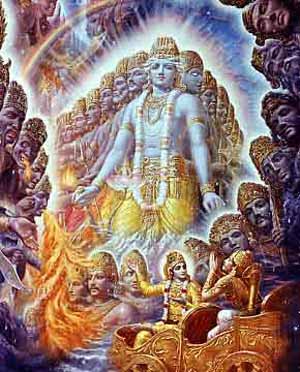
Vishnu - the Maintainer, Preserver is most famously identified with His avatars, or incarnations of God, most especially Krishna and Rama. Additionally, another important name for Vishnu is Narayana.
The Vishnu Sahasranama declares Vishnu as Paramatma (supreme soul) and Parameshwara (supreme God). It describes Vishnu as the All-Pervading essence of all beings, the master of - and beyond - the past, present and future, the creator and destroyer of all existences, one who supports, sustains and governs the Universe and originates and develops all elements within.
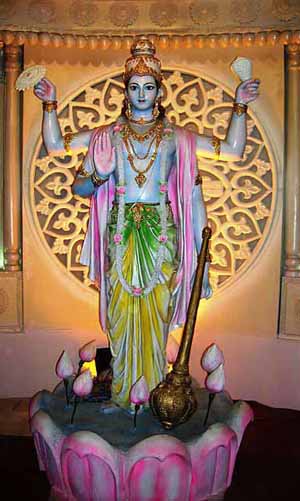
In the Puranas, Vishnu is described as having the divine color of water filled clouds, four-armed, holding a lotus, mace, conch (shankha) and chakra (wheel). Vishnu is also described in the Bhagavad Gita as having a 'Universal Form' (Vishvarupa) which is beyond the ordinary limits of human perception.
The Purana also describe each of the Dasavatara of Vishnu. Among these ten principal avatara described, nine have occurred in the past and one will take place in the future, at the end of Kali Yuga. In the commentary of creator Brahma in Vishnu Sahasranamam, he refers to Vishnu as "Sahasrakoti Yuga Dharine", which means that these incarnations take place in all Yugas in cosmic scales. The Bhagavad Gita mentions their purpose as being to rejuvenate Dharma and vanquish negative forces as also to display His divine pastimes in front of the conditioned/fallen souls. In almost all Hindu denominations, Vishnu is either worshiped directly or in the form of his ten avatara, such as Rama and Krishna.
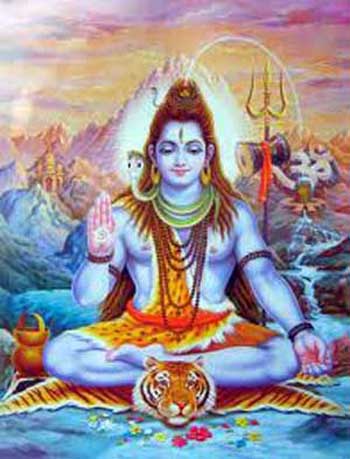
Shiva is considered to be the supreme deity in Shaivism, a denomination of Hinduism. Many Hindus such as those of Smarta tradition are free to accept various manifestations of the divine as their chosen deity for worship, and those who prefer Shiva are called Shaivas. Shaivism, along with Vaisnava traditions that focus on Vishnu, and Sakta traditions that focus on the Goddess (Devi) are three of the most influential denominations in Hinduism.
The worship of Shiva is a pan-Hindu tradition, practiced widely across all of India. Shiva is one of the five primary forms of the Divine in Smartism, a denomination of Hinduism that puts particular emphasis on five deities, the other four being Vishnu, Devi, Ganesha, and Surya.
Another way of thinking about the divinities in Hinduism identifies Brahma, Vishnu, and Shiva as each representing one of the three primary aspects of the Divine in Hinduism, known collectively as the Trimurti. In the Trimurti system, Brahma is the creator, Vishnu is the maintainer or preserver, and Shiva is the destroyer or transformer.
- Third Eye: Shiva is often depicted with a third eye with which he burned Desire (Kama) to ashes.
- Serpents: Shiva is often shown garlanded with a snake.
- Crescent: Shiva bears on his head the crescent of the fifth day (panchami) moon. This is placed near the fiery third eye and this shows the power of Soma, the sacrificial offering, which is the representative of moon. It means that Shiva possesses the power of procreation along with the power of destruction.The moon is also a measure of time; thus the Crescent also represents his control over time. Thus Shiva is known by the names of Somasundara and Chandrashekara.
- Sacred Ganga: Ganga, the holiest of the holy rivers, flows from the matted hair of Shiva. Shiva allowed an outlet to the great river to traverse the earth and bring purifying water to human beings. The flowing water is one of the five elements which compose the whole Universe and from which earth arises. Ganga also denotes fertility one of the creative aspect of Shiva.
- Drum: A small drum shaped like an hourglass is known as a "damaru". This is one of the attributes of Shiva in his famous dancing representation known as Nataraja. A specific hand gesture (mudra) called damaru-hasta (Sanskrit for "damaru-hand") is used to hold the drum. This drum is particularly used as an emblem by members of the Kapalika sect.
- Vibhuti: Vibhuti is three lines of ashes drawn on the forehead that represents the essence of our Being, which remains after all the malas (impurities of ignorance, ego and action) and vasanas (likes and dislikes, attachments to one's body, world, worldly fame, worldly enjoyments, etc.) have been burnt in the fire of knowledge. Hence vibhuti is revered as the very form of Shiva and signifies the Immortality of the soul and manifested glory of the Lord.
- Ashes: Shiva smears his body with ashes (bhasma). Some forms of Shiva, such as Bhairava, are associated with a very old Indian tradition of cremation-ground asceticism that was practiced by some groups who were outside the fold of brahmanic orthodoxy. These practices associated with cremation grounds are also menteioned in the Pali canon of Theravada Buddhism. One epithet for Shiva is "Inhabitant of the cremation ground" referring to this connection.
- Tiger skin: He is often shown seated upon a tiger skin.
- Elephant and Deer Skin: Shiva also wears elephant skins. Similarly deer represent the jumping of minds (flickering mind). Shiva wears deer skin which indicates that he has controlled the mind perfectly.
- Trident: (Sanskrit: Trishula) Shiva's particular weapon is the trident.
- Nandi, the Bull, is his Vahana (Sanskrit for vehicle).
- Lingam:Shiva is often worshipped in the form of a lingam.These are depicted in various forms. Mount Kailasha in the Himalayas is his traditional abode.
- He is often represented as immersed in deep meditation.
- He is said to eradicate Kama (sexual desire), Moha (material desire) and Maya (mundane thoughts) from his devotees' minds.
Thus Indra, the chief of the gods, was regarded as the regent of the east; Agni, the fire, was in the same way associated with the southeast; Yama with the south; Surya, the sun, with the southwest; Varuna, originally the representative of the all-embracing heaven (atmosphere), now the god of the ocean, with the west; Vayu (or Pavana), the wind, with the northwest; Kubera, the god of wealth, with the north; and Soma with the northeast. (Note: In some traditions, Eesana, an aspect of Siva is regarded as the regent of the northeast and Nirrti the regent of the southwest.)
In the institutes of Manu the Loka palas are represented as standing in close relation to the ruling king, who is saki to be composed of particles of these his tutelary deities. The retinue of Indra consists chiefly of the Gandharvas, a class of genii, considered in the epics as the celestial musicians; and their wives, the Apsaras, lovely nymphs, who are frequently employed by the gods to make the pious devotee desist from carrying his austere practices to an extent that might render him dangerous to their power. Narada, an ancient sage (probably a personification of the cloud, the water-giver), is considered as the messenger between the gods and men, and as having sprung from the forehead of Brahma.
The interesting office of the god of love is held by Kamadeva, also called Ananga, the bodyless, because, as the myth relates, having once tried by the power of his mischievous arrow to make Siva fall in love with Parvati, whilst he was engaged in devotional practices, the urchin was reduced to ashes by a glance of the angry god. Two other mythological figures of some importance are considered as sons of Siva and Parvati, viz. Karttikeya or Skanda, the leader of the heavenly armies, who was supposed to have been fostered by the six Knittikas or Pleiades and Ganesha (lord of troops).
Other denominations of Hinduism do not strictly hold this belief. Only a Smartist would have no problem worshiping Shiva or Vishnu together as he views the different aspects of God as leading to the same One God. It is the Smarta view that dominates the view of Hinduism in the West. By contrast, a Vaishnavite considers Vishnu as the one true God, worthy of worship and other forms as subordinate.
Vedic Deities - These deities represent forces of nature or devas and are not equivalent to Brahman represented as Vishnu or Shiva. The Devas hold a similar place in relation to God as angels do in Judaeo-Christian traditions.
Ancient India - Goddesses
Ananta - Indian Serpent Queen. aka Sarparajni. She enveloped all gods during their death, sleeping between incarnations.
Banka-Mundi - Hunting Goddess of the Khoud. Merely uttering Her name made one fearless against jungle beasts.
Bardaichila - Assamese Storm Goddess.
Bentakumari - Assamese Water Goddess. First fish of the season was given to Her.
Bhasundara - Tibetan Goddess of Prosperity
Bhavani - Common name for Mother Goddess of India. Bestower of Existence. Evoked by women in labor, who burned perfume to honor Her.
Bisal-Mariamna - Shakti of Sunlight in Mysore. Symbolized by a brass pot full of water called the Kunna-Kannadi or 'eye mirror'. Into this pot are put pepper leaves and coconut flowers, a small metal mirror leans against it.
Budhi Pallien - Assamese Forest Goddess, appears as a tiger roving through the Indian jungle.
Chomo-Lung-Ma - Goddess Mother of the Universe, original name of Mt. Everest. One of the oldest Indian deities.
Devi - Dearly Beloved Goddess
Durga - the Queen Mother, Warrior Goddess, rode tigers into battle defending Her children, the gods.
Hudigamma - Hindu Mother Goddess served by eunuch priests dressed in women's clothes.
Indrani - Queen of the gods.
Ista Devata - Tantric Patroness of the Self. Individual Guardian Angel of the Enlightened Sage.
Kadru - Serpent Goddess, Mother of the Nagas, or Cobra people.
Kali - Black Earth Mother, Conqueror of Time, Goddess of fertility, death and regeneration.
Dark Mother, Hindu triple Goddess of creation, preservation and destruction. Birth and Death Mother. Treasure house of Compassion, Giver of Life to the World. Her mantras brought into being the very things whose names She spoke for the first time, Originator of the creative word or Logos. A triple Goddess - Maiden, Mother, Crone. Lady of the Dead. The Ocean of Blood at the beginning and end of the world. Also known as Jagadamba.
Kauri - Indo-European Swan Goddess. Cowrie shell was sacred to Her.
Khon-Ma - Mother Earth, Ruler of All Spirits emanating from the Earth element.
Kundalini - Serpent Goddess representing the inner power of the human body
Kurukulla - Dravidian Goddess of Caverns.
Lakshmi - Goddess of fortune,wealth and abundance. Portrayed as a golden skinned woman sitting or standing on a lotus, Her symbol. Hindu Goddess of Sovereignty. Source of the divine drink Soma. aka Padma, Lady Lotus. Goddess of Beauty and Good Fortune.
Manasa-Devi - Serpent Goddess of Bengal, identified with the Moon, bearing the Moons's magic name Mana.
Marici - Buddhist Diamond Sow, Great Goddess seated on a lotus surrounded by 7 pigs. Glorious One. Sun of Happiness.
Maya - Virgin aspect of the triple Hindu Goddess, symbolized by a Spider, spinner of magic, fate and earthly appearances. The spider's web was likened to the Wheel of Fate and the spider to the Goddess as a Spinner, sitting at the hub of Her Wheel. Mother of the Enlightened One, Buddha. Her colors were white, red and black. Hawthorne, Her tree.
Nanda Devi - Blessed Goddess. Mountain Mother Who gave birth to the Ganges. Nanda Devi is one of the Holiest Mountains of the Himalayan chain.
Parvati - Maiden aspect of Kali. Daughter of the Mountain. Shiva's bride. Daughter of Heaven. Also known by Maya, Sati, Durga, Shakti, Privithi. Dark and colorful, ornate and mysterious. The richness of hues in Her attire as well as Her jewels symbolize Her power. She lifts Her veil to reveal Her beauty, shining like the Sun rising over the mountain of Anapurna. The cocoon, butterfly and the karmic golden wheel reflect Her deep connection with life and death, cause and effect, and transformation.
Prajnaparamita - Personification of Wisdom
Prakriti - Nature. Sanskrit title of Kali as female Holy Trinity, commanding the Gunas, the white, red and black threads of Creation, Preservation and Destruction. She embodied past, present, future; earth, sea, sky; youth, maturity, age.
Privithi - Very ancient Earth Mother.
SaraÊ Kali - Queen Kali, Mother Goddess of the gypsies. The Mother, the Woman, the Sister, the Queen, the source of all Romany blood. Queen of Heaven and Earth.
Sarama - Vedic Bitch Goddess, Mother of the brindled Dogs of Yama. The Huntress.
Saranyu - Goddess Who gave birth to all animals, Mother of all Creatures. Vedic Mare Goddess, Mother of the Centaurs.
Sarasvati - White skinned Goddess of poetry, music, science and learning as well as all creative arts. Inventor of the Sanscrit language. She wears a crescent moon on her brow and rides a swan or a peacock, or is seated on a lotus. The Flowing One. Inventor of all the arts of civilization: music, letters, mathematics, calendars, magic, the Vedas and all other branches of learning. Ancient River Goddess. Queen of Heaven. Mother of Waters. aka Ganga. Originally a River Goddess, She originated in the Ocean. Great culinary Goddess, She invented Soma, or Amrita (drink of bliss). Independent of nature. Goddess of sensual love, creativity, beauty, art and music. Goddess of learning and teaching
Savitri - Hindu Mother of Civilization, She Who brought forth music and literature, rhythm, time, measurements, day and night, memory, conquest, victory and yoga.
Shakti - Tantric title of the Great Goddess. Cosmic Energy. The Tantras say the female principle antedates and includes the male principle and this female principle is the Supreme Divinity. Tantric doctrine says mortal women are life itself, and Goddess-like, because they embody the principle of Shakti. The series of Universes appear and disappear with the opening and shutting of her eyes. (from the Lalita Sahasranamam) Final union with Shakti occurred at the moment of Death, according to Tantric mystics.
Shasti - Bengali Feline Goddess, depicted riding a cat. Goddess of childbirth and Protectress of Children.
Shitala - Protectress against small pox. Mothers appealed to Her for help for their children.
Sita - Furrow, the Goddess Earth as the wife of Rama (Krishna).
Smashana-Kali - Kali Ma as the Goddess of cremation grounds and other places of Death. Her yantra was an 8 petaled lotus with multiple repetitions of the inverted triangle. The meaning was Rebirth following Death. Her priestesses, called dakinis, arranged funerals and tended the dying.
Tara - Pre-Vedic Savior Goddess, known from India to Ireland. Indo-European primal Goddess Earth. An extremely ancient festival held annually at Athens was named after Her, Taramata (Mother Tara) nicknamed The Rioting because of its wild orgiastic customs. The sacred grove of Tara in Ireland was the Goddess's genital shrine. In India, Tara is called The Most Revered of the old pre-vedic Goddesses. Wine is sacred to Her. Goddess of Compassion, The Diamond Sow. Diamonds are Her sacred stone. Tibetan Buddhist Great Mother. She is a Boddhisattva, an enlightened One who has vowed to incarnate until all beings have attained enlightenment. She also vowed to incarnate only as a female. She governs the Underworld, the Earth and the Heavens, birth, death and regeneration, love and war, the seasons, all that lives and grows, the Moon cycles. Green Tara is Her Nature-related aspect. Typically She is seen as a slender and beautiful woman of white complexion, long golden hair and blue eyes. She can also appear as red, black or dark blue. Her animals are the sow, mare, owl and raven. Goddess of spiritual transformation. When worshiping Tara, recognize all you see as Her body, made of green light, all you hear is Her divine speech, and all your thoughts as Her divine wisdom. Every molecule of air is Her divine energy and when you lie down, your head rests in Her lap.
Uma - The Golden Goddess, personifying light and beauty. Daughter of the Mountains, Patroness of yogic ascetism. Kali's Crone aspect. aka Prisni, Mother of the Dark Season, Daughter of Heaven. Mother Death.
Ushas - Vedic Goddess of the Dawn.
Mother Goddesses
List of Hindu Deities
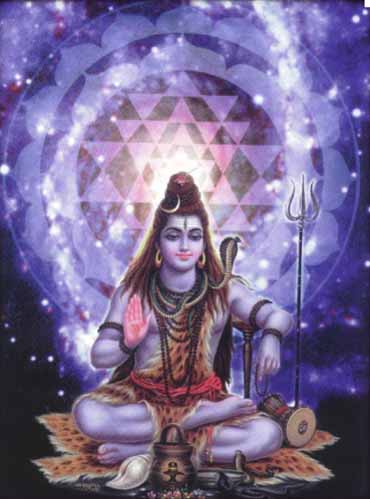

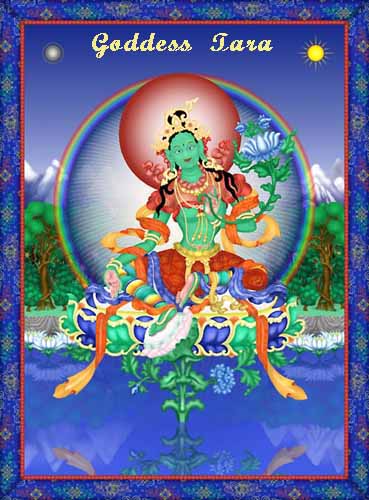
No comments:
Post a Comment